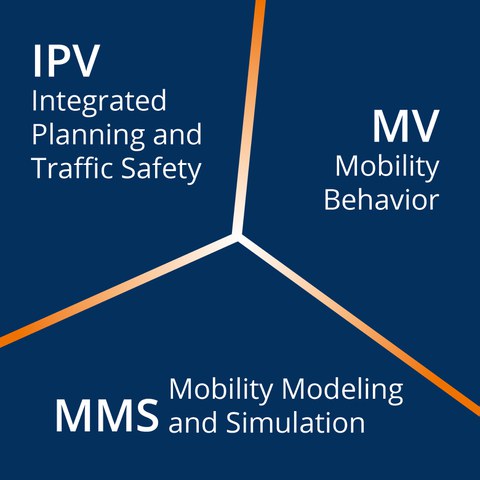Areas of Research

Reasearch Areas
The three research fields of the chair are closely interrelated with diverse dependencies and synergies. Research on mobility behavior and the corresponding empirical methods is linked to mobility modeling and simulation, both feeding into the planning of sustainable mobility systems including safe and attractive streetscapes.
Below you can find more information about our areas of research:
|
The object of the research field MV is the further development of methods for the survey and analysis of mobility behavior and the application of these to investigate and explain mobility behavior and to develop strategies to influence it in a targeted way. Our work in the research field is divided into the following three topics: |
01. Research in the field of "Data Science" for the explanation of behavioral phenomena and the recognition of new behavioral patterns (traffic sociological root causal research of traffic development processes)
- Teaching and development of data competencies as "tools of the trade", especially for data preparation and analysis in the field of mobility
- Use of microdata from household surveys as a basis for answering research questions on mobility behavior
- Identification of characteristics describing and explaining mobility based on requirements of science and practice
- Preparation and use of the extensive SrV database for the analysis of city-specific and city-wide developments in mobility behavior
- Analysis of influencing variables and changes in traffic behavior, primarily using the survey tool "Mobility in Cities - SrV"
- Development of technical aids and interactive tools for mobility analysis
02. Research on survey instruments
- State-of-the-art application of established survey methods as well as the development of new innovative ones for the valid recording of everyday mobility
- Further development of methods and tools to assure data quality in the recording of everyday mobility
- Main topics are studies on willingness to participate, selectivity, non-response and method effects, (non-behavior impacting) motivation to participate, innovative recruitment strategies
- Combining self-collected data with existing data (e.g., spatial information, mobile phone data, FCD, social media)
03. Research on strategies and measures to influence mobility behavior (closely linked to IPV)
- Mobility management and all associated strategies targeting specific groups of people
- Active mobility (walking and cycling) and reduction of car dependency
- Addressing urban, small-town, and rural mobility
- Integration with greenhouse gas and air pollutant calculations
- Effectiveness studies of interventions
The subject of the research field IPV is the development of methods for the analysis of mobility systems and their application to examine traffic safety and the use of road spaces as well as to develop strategies for safe and sustainable mobility systems. Our work in the research field IPV is divided into the following four topics:
01. Traffic data acquisition on the street
- Development of innovative methods, tools and workflows
-
for the collection, automated processing and analysis of traffic data in street space as well as infrastructure data,
- for deriving traffic data from the street environment
- for the automated generation of road traffic parameters to describe traffic flows, the movement of individual vehicles and road users as well as trajectories from which conflict measures such as "Surrogate Safety Measures" can then be derived
- Implementation of these measures in OpenTrafficCam (OTC)
-
Application of traffic data collection methods especially for pedestrian and bicycle traffic
02. Strategic concepts of mobility planning
- Stakeholders, processes, goals and results of strategic mobility planning
- Strategic development of street networks with a focus on urban spaces
- Transformation experiments to test sustainable mobility measures
03. Design of attractive streets, paths and squares
- Interactions between design and operation of streets and public spaces with their use, acceptance, stay activities with a focus on pedestrian and bicycle traffic, as well as micromobility
- International practices of streetscape design
-
Flexible streetscape design (e.g. alternating uses)
- Street spaces for future uses with consideration of the automation of road traffic
-
Processes for negotiating solutions for the design of street spaces
-
Monitoring and evaluation of transformation experiments and/or traffic trials
04. Design of safe streets, paths and squares
- Methods for analyzing traffic safety in close cooperation with OTC
- Based on accident data, on-site data from imaging techniques such as video, GIS and other data to describe exposure and influencing factors
- Further development and application of conflict measures or parameters of safety-relevant behavior
- Application of the methods to specific issues, e.g. traffic safety of specific groups of people, vehicle fleets (e.g. e-bikes, cargo bikes) or infrastructures
- Derivation and evaluation of measures to improve traffic safety
The main focus of the MMS research field is the further development of models, in particular simulation models, with the aim of using them to explore possible solutions to societally relevant problems. The thematic focal points are:
01. Methods for creating traffic simulation models based on Open Data and the transferability of the approaches
02. Recording modes of active mobility in traffic simulation models
03. Modeling of traffic and spatial effects in the overall city system
04. Accessibility analyses
05. Models as a participatory planning tool
